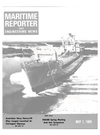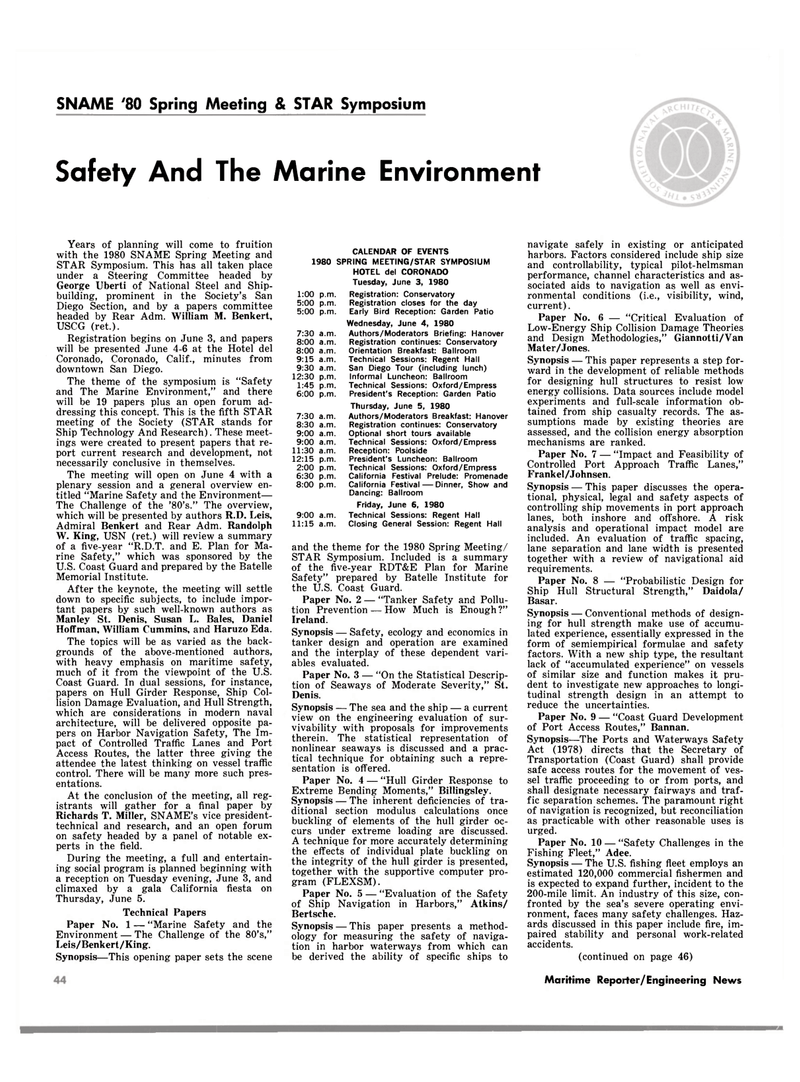
Page 44: of Maritime Reporter Magazine (May 1980)
Read this page in Pdf, Flash or Html5 edition of May 1980 Maritime Reporter Magazine
SNAME '80 Spring Afleeting & STAR Symposium
Safety And The Marine Environment
Years of planning will come to fruition with the 1980 SNAME Spring Meeting and
STAR Symposium. This has all taken place under a Steering Committee headed by
George Uberti of National Steel and Ship- building, prominent in the Society's San
Diego Section, and by a papers committee headed by Rear Adm. William M. Benkert,
USCG (ret.).
Registration begins on June 3, and papers will be presented June 4-6 at the Hotel del
Coronado, Coronado, Calif., minutes from downtown San Diego.
The theme of the symposium is "Safety and The Marine Environment," and there will be 19 papers plus an open forum ad- dressing this concept. This is the fifth STAR meeting of the Society (STAR stands for
Ship Technology And Research). These meet- ings were created to present papers that re- port current research and development, not necessarily conclusive in themselves.
The meeting will open on June 4 with a plenary session and a general overview en- titled "Marine Safety and the Environment—
The Challenge of the '80's." The overview, which will be presented by authors R.D. Leis,
Admiral Benkert and Rear Adm. Randolph
W. King, USN (ret.) will review a summary of a five-year "R.D.T. and E. Plan for Ma- rine Safety," which was sponsored by the
U.S. Coast Guard and prepared by the Batelle
Memorial Institute.
After the keynote, the meeting will settle down to specific subjects, to include impor- tant papers by such well-known authors as
Manley St. Denis, Susan L. Bales, Daniel
Hoffman, William Cummins, and Haruzo Eda.
The topics will be as varied as the back- grounds of the above-mentioned authors, with heavy emphasis on maritime safety, much of it from the viewpoint of the U.S.
Coast Guard. In dual sessions, for instance, papers on Hull Girder Response, Ship Col- lision Damage Evaluation, and Hull Strength, which are considerations in modern naval architecture, will be delivered opposite pa- pers on Harbor Navigation Safety, The Im- pact of Controlled Traffic Lanes and Port
Access Routes, the latter three giving the attendee the latest thinking on vessel traffic control. There will be many more such pres- entations.
At the conclusion of the meeting, all reg- istrants will gather for a final paper by
Richards T. Miller, SNAME's vice president- technical and research, and an open forum on safety headed by a panel of notable ex- perts in the field.
During the meeting, a full and entertain- ing social program is planned beginning with a reception on Tuesday evening, June 3, and climaxed by a gala California fiesta on
Thursday, June 5.
Technical Papers
Paper No. 1 — "Marine Safety and the
Environment — The Challenge of the 80's,"
Leis/Benkert/King.
Synopsis—This opening paper sets the scene
CALENDAR OF EVENTS 1980 SPRING MEETING/STAR SYMPOSIUM
HOTEL del CORONADO
Tuesday, June 3, 1980 1:00 p.m. Registration: Conservatory 5:00 p.m. Registration closes for the day 5:00 p.m. Early Bird Reception: Garden Patio
Wednesday, June 4, 1980 7:30 a.m. Authors/Moderators Briefing: Hanover 8:00 a.m. Registration continues: Conservatory 8:00 a.m. Orientation Breakfast: Ballroom 9:15 a.m. Technical Sessions: Regent Hall 9:30 a.m. San Diego Tour (including lunch) 12:30 p.m. Informal Luncheon: Ballroom 1:45 p.m. Technical Sessions: Oxford/Empress 6:00 p.m. President's Reception: Garden Patio
Thursday, June 5, 1980 7:30 a.m. Authors/Moderators Breakfast: Hanover 8:30 a.m. Registration continues: Conservatory 9:00 a.m. Optional short tours available 9:00 a.m. Technical Sessions: Oxford/Empress 11:30 a.m. Reception: Poolside 12:15 p.m. President's Luncheon: Ballroom 2:00 p.m. Technical Sessions: Oxford/Empress 6:30 p.m. California Festival Prelude: Promenade 8:00 p.m. California Festival — Dinner, Show and
Dancing: Ballroom
Friday, June 6, 1980 9:00 a.m. Technical Sessions: Regent Hall 11:15 a.m. Closing General Session: Regent Hall and the theme for the 1980 Spring Meeting/
STAR Symposium. Included is a summary of the five-year RDT&E Plan for Marine
Safety" prepared by Batelle Institute for the U.S. Coast Guard.
Paper No. 2 — "Tanker Safety and Pollu- tion Prevention — How Much is Enough?"
Ireland.
Synopsis — Safety, ecology and economics in tanker design and operation are examined and the interplay of these dependent vari- ables evaluated.
Paper No. 3 — "On the Statistical Descrip- tion of Seaways of Moderate Severity," St.
Denis.
Synopsis — The sea and the ship — a current view on the engineering evaluation of sur- vivability with proposals for improvements therein. The statistical representation of nonlinear seaways is discussed and a prac- tical technique for obtaining such a repre- sentation is offered.
Paper No. 4 — "Hull Girder Response to
Extreme Bending Moments," Billingsley.
Synopsis — The inherent deficiencies of tra- ditional section modulus calculations once buckling of elements of the hull girder oc- curs under extreme loading are discussed.
A technique for more accurately determining the effects of individual plate buckling on the integrity of the hull girder is presented, together with the supportive computer pro- gram (FLEXSM).
Paper No. 5 — "Evaluation of the Safety of Ship Navigation in Harbors," Atkins/
Bertsche.
Synopsis — This paper presents a method- ology for measuring the safety of naviga- tion in harbor waterways from which can be derived the ability of specific ships to navigate safely in existing or anticipated harbors. Factors considered include ship size and controllability, typical pilot-helmsman performance, channel characteristics and as- sociated aids to navigation as well as envi- ronmental conditions (i.e., visibility, wind, current).
Paper No. 6 — "Critical Evaluation of
Low-Energy Ship Collision Damage Theories and Design Methodologies," Giannotti/Van
Mater/Jones.
Synopsis — This paper represents a step for- ward in the development of reliable methods for designing hull structures to resist low energy collisions. Data sources include model experiments and full-scale information ob- tained from ship casualty records. The as- sumptions made by existing theories are assessed, and the collision energy absorption mechanisms are ranked.
Paper No. 7 — "Impact and Feasibility of
Controlled Port Approach Traffic Lanes,"
Frankel/Johnsen.
Synopsis — This paper discusses the opera- tional, physical, legal and safety aspects of controlling ship movements in port approach lanes, both inshore and offshore. A risk analysis and operational impact model are included. An evaluation of traffic spacing, lane separation and lane width is presented together with a review of navigational aid requirements.
Paper No. 8 — "Probabilistic Design for
Ship Hull Structural Strength," Daidola/
Basar.
Synopsis — Conventional methods of design- ing for hull strength make use of accumu- lated experience, essentially expressed in the form of semiempirical formulae and safety factors. With a new ship type, the resultant lack of "accumulated experience" on vessels of similar size and function makes it pru- dent to investigate new approaches to longi- tudinal strength design in an attempt to reduce the uncertainties.
Paper No. 9 — "Coast Guard Development of Port Access Routes," Bannan.
Synopsis—The Ports and Waterways Safety
Act (1978) directs that the Secretary of
Transportation (Coast Guard) shall provide safe access routes for the movement of ves- sel traffic proceeding to or from ports, and shall designate necessary fairways and traf- fic separation schemes. The paramount right of navigation is recognized, but reconciliation as practicable with other reasonable uses is urged.
Paper No. 10 — "Safety Challenges in the
Fishing Fleet," Adee.
Synopsis — The U.S. fishing fleet employs an estimated 120,000 commercial fishermen and is expected to expand further, incident to the 200-mile limit. An industry of this size, con- fronted by the sea's severe operating envi- ronment, faces many safety challenges. Haz- ards discussed in this paper include fire, im- paired stability and personal work-related accidents. (continued on page 46) 10 Maritime Reporter/Engineering News

 43
43

 45
45
